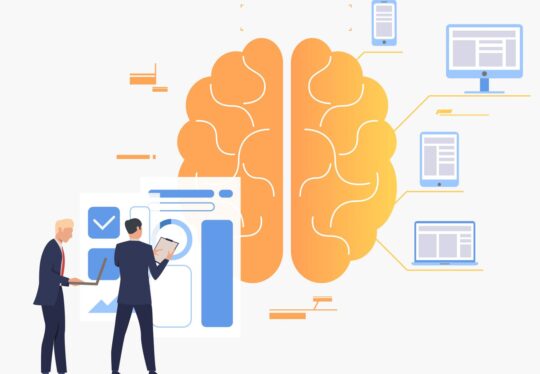Part 1: What is Thinking?
Defining thinking is a notoriously difficult task. Let me begin with a story out of the Zen Buddhist attempts to define what thinking is. The tale, what is called a puzzle for meditation, a koan, illustrates what is meant by thinking in the following example.
Two monks were arguing about a flag. One said: “The flag is moving.”
The other said: “The wind is moving.”
The sixth patriarch happened to be passing by.
He told them: “Not the wind, not the flag; mind is moving.” (Reps and Senzaki, 1998)
We can see in this story at least three different kinds of thinking:
- The first one is an instant, intuitive perception without much reflection at all. Perhaps there was heard a flapping sound, and the startled reaction was to turn toward the sound and respond.
- The second one is analytical reflection involving identifying a chain of cause and effects by using the logical, reflective parts of the mind.
- The patriarch brings them together into a higher synthesis in thinking, which is a primary aim of this article. It’s when thinking in its different purposes and components flow powerfully together. In academic language , it is meta-thinking, or “thinking about thinking”.

Table of Contents:
-
Part 1: What is Thinking?
-
Part 2: The 2 Types of Thinking: Fast and Slow
-
Part 3: Cognitive Bias
-
Part 4: Logic
-
Part 5: Computational Thinking (CT)
Without the mind’s ability to give life meaning by thinking more fully, our world would be a hollow and despairing place. It is the mind’s ability to navigate our way through the world that makes us emotionally and psychologically fit in times of crisis. It is the mark of a truly adjusted and mature individual to bring to every moment of life the full power to put our greatest tool, our ability to think, to navigate our daily tasks and challenges (Orlando and Pierce, 2016).
The powered software of directed purposeful thinking in our heads is astonishingly more powerful than any of us thinks, as we shall witness in this article. For now let’s look into our toolbox and take out the tools that need to work together when we give thoughts to things.
What is the purpose of thinking?
As we shall see, thinking, is an abstract mental activity. It can be used in different circumstances and it can bring different outcomes, depending how well we have mastered the art of thinking. Below is a limited list of where thinking is utilized, can you identify other methods thinking is used for?
- Making important decisions
- Formulating proposals and logical alternatives
- Being creative and working out-of-the-box.
- Planning for the future.
- Remembering and bringing up solutions from the past
- Learning new skills (Baron, 2000)
The point is that these objectives interpenetrate. For the very same problem , you may need all of the above at the same time, regardless of whether through the analytical, the intuitive system or both mutually reinforcing.
The legendary Zen master Takuan Sōhō calls for “mushin” literally “no-mind” when a warrior’s mind is free to act and react at a very high speed, but with intention, plan or direction that took place through rigorous learning, retained in memory and creatively applied.
When the swordsman stands against his opponent, he is not to think of the opponent, nor of himself, nor of his enemy’s sword movements. He just stands there with his sword which, forgetful of all technique, is ready only to follow the dictates of the subconscious.
The man has effaced himself as the wielder of the sword. When he strikes, it is not the man but the sword in the hand of the man’s subconscious that strikes. (Sabo, 2013) So can we wield the power of our mind with mastery just as the swordsman with his sword.
These Eastern interpretations of thinking define it as a tool through which we express ourselves and achieve our inner potential. In this context thinking can be improved and sharpened, just like a sword after practice.
In the next section of this article, we will look at thinking through the lens of Western understanding and scientific inquiry.
Part 2: The 2 Types of Thinking: Fast and Slow
Seymour Epstein advanced a revolutionary theory of heuristic or “thinking about thinking”. One situation may require System 1 (based on intuitions and instincts), another System 2 (based on rational thinking).
The two are used very differently, one associated with feelings and experience and the other with intellect, logic, and thinking things through. System 1 (Fast thoughts) is fast, efficient, requires little energy though when it is employed, we jump to conclusions and errors based on limited information.
System 2 (slow thoughts) constitutes the analytical, “critical thinking” way of making decisions. Just as mind cannot be separated from the body, so feelings cannot be separated from thought. How the two systems work at their best together is the main theme of this section. (Kahneman, 1994)
Unless you occasionally go against your gut, you haven’t put your intuition to the test. You can’t really know it’s helping you make good choices if you’ve never seen what happens when you don’t go beyond system 1. . Your first impression is generated without much conscious effort and channels the available information through the memory based on similar past situations, really just a “gut feeling”.
When problems are routine and when under time constraint, System 1 kicks in. Higher level cognitive operations belong to System 2, the more “analytical,” “deliberate” and “rational” side to the thinking process. System 2 is logical judgment, through a conscious application of logical rules, making it less prone to error, where the real action is for dependable results.
But we don’t set aside emotion when we employ logic, unlike a thinking machine. We are humans who combine both sides of the brain into a single flow of thought. Emotions are, after all, a central part of the psychological process of motivation, the process that activates and guides the reason toward particular ends, and energizes you to pursue them by developing appropriate `coping strategies.
Emotions tell you what needs attention (Kaufman, 1999).It is the two wings on which thinking flies most true. The main thing to learn is mindfulness, watching ourselves to identify positive and negative emotions which might upset us or trigger some kind of positive reaction. Pay close attention to how our minds react when feeling and thought come together.
The great modernist poet, T.S. Eliot was very upset with modern ways of thinking which sought to rise thought over feeling causing he felt our modern anxieties and insecurities concealed as rational thought. He called it “a disassociation of sensibility” and called upon modern man to return feeling to thought. It can be dangerous to rely too heavily on what experts call System 1 thinking instead of logically working through the information that’s available, but how do you check up on gut feeling?
Think of probability
You have a plan. It looks so promising that you want to act fast. It doesn’t matter whether it’s planning for an important business deal or a family trip. Think it through. You have alternatives. Always. Think in terms of probability. Your guesses should be within the realm of possibility with at least three estimates at the end of it is almost impossible, almost certain, and the most dangerous and one to watch out for, the 50% chance. This method helps you to prepare backup plans and exit strategies.
Prospective hindsight
This is a military exercise in strategic thinking. Imagine that you had failed, and with that rise the feelings that arise leading you to follow that mood of defeat back to what would have caused it at a time when your feelings made you secure that you would succeed. Thinking in this way checks false feelings of optimism to encourage a more realistic assessment of risk. The method can highlight factors that will influence success or failure, which may increase your ability to control the results.

Part 3: Cognitive Bias
A cognitive bias consists of a ‘systematic error’ in the thinking process You may have learned in school that there are two principle forms of logic. There is “deductive logic” by which you state a principle that cannot be disproven, a thesis, and then apply that thesis to the problem to get a solution. “Inductive logic” functions differently.
In this form of logic, you begin with a problem, gather all the data related to the problem, and base a conclusion, sometimes a solution, exclusively on solid evidence. If you had a teacher explain how to write a college paper or scientific report, that is the kind of thinking you need to do for any form of reporting in business and industry.
But what about everyday life?
In our ordinary experience, we are more likely to react along the lines of System 1 (our gut instincts) tempered by the reflective thought of System 2. The question now is how precisely does system 2 check on System 1. Here is the problem. Sometimes, you have time to ponder a problem and the means to look into your feelings as you deploy the instruments of System 2.
But what if you don’t. That is when you bring your knowledge of cognitive bias to bear on your problem. Basically cognitive bias is a scientifically based system that shows how our initial perception in Sector 1 can lead us into error Can you trust your own senses? Not always. These are some of the ways you check up on first impression.
The Dunning-Kruger Effect
Coined in 1999 by psychologists David Dunning and Justin Kruger, The Dunning-Kruger Effect is a cognitive bias whereby people who are incompetent at something not only fail to recognize their incompetence, but are sure that they are more competent than those with genuine expertise. Somehow, pride can make us stubborn, and stick to our opinion even when presented with evidence to the contrary, disregarding expert opinions.
The person may tell you that the expert opinion is “fake,” the expert was “paid off” to give that opinion, or he or she may just talk over you so that you can’t get your facts heard. Since you can’t prove that something didn’t happen, you walk away frustrated, while the other person is more entrenched in his or her beliefs. Don’t be like that. Not only do these people make terrible mistakes, but their incompetence robs them of the ability to realize it.
Affect Heuristic
Paul Slovic led a team that invented affect heuristic as an important barrier to merging logical thought and emotion because people let their emotions color their beliefs about the world, and therefore the way we perceive the risks and benefits of different courses of action. Our emotions also affect the way we compare dangers. For example, people tend to dread being struck by lightning during a storm, but confidently undertake the dangers of the highway every day.
Almost always terrible decisions are made when we say, “You know, I have a good feeling about it. You have taken a dangerous mental shortcut that allows people to make decisions quickly by bringing their emotional response into play and act according to their gut feeling. When you have a pleasant feeling about something, you see the benefits as high and the risks as low, and when something in a person or a situation makes you feel bad, for instance by hurting your pride, you may well perceive danger more than opportunities in a given situation.
Gambler’s Fallacy (Monte Carlo Fallacy)
Flip a coin. Now, what is your chance that the coin will land heads or tails. Precisely 50% every time. Now, what the coin lands heads up 7 times in a row and you are a gambler, what would you bet. Most would pick red according to non-existent odds. If that coin were dropped one after another all day and night, the average would be, well, 50%.
But it is possible for it to land on one or another side over a very brief period to average out later. Don’t be fooled by a gambler’s luck. In the end, the house always wins. It is a terrible mistake to think that if something happens more or less frequently than normal during a certain period, it will happen that way in the future.
The Fundamental Attribution Error
The Fundamental Attribution Error is something we have to be careful about. It is our own ego distorting our primary perception of what we observe and think as objective fact. It works like this: when we fail , it is not our fault , but circumstances were just against us. Not so when others fail.
Now, there is some deficit to their character, making them poor because they did not work hard, or a criminal because they were born that way. Sometimes, we blame the victim of rape unfairly because of the suggestive outfit, or the homeless for being lazy, disregarding the social and economic context
Selective Inattention
You may never have heard of the famous “invisible gorilla” experiment. Psychologists Christopher Chabris and Daniel Simons created a short film in which, in the middle of an exciting basketball game in which the subjects of the experiment were asked to keep score , a woman wearing a gorilla suit crosses the court, thumps her chest, and walks off screen.
She’s on screen for a total of nine seconds. Most of the people didn’t see it, though when asked if they would notice the gorilla in this situation, nearly everyone says they would. What can we learn from this situation: that we are missing a lot of what goes on around us, and that we have no idea that we are missing so much.
Confirmation Bias
We all favor ideas that confirm our existing beliefs and what we think we know. Once we have formed a view, we want to confirm that view, while ignoring, or rejecting, information that casts doubt on it.
That may make us feel good because they confirm our prejudices, though we are led to error by our own assumptions. When people would like a certain idea to be true, they end up believing it to be true. And nothing will change their minds because they had made earlier such emotional commitment to their views.
Bounded Rationality
This may be the most important. We are all limited, fallible, and need to be aware of our own capacity to be led astray by egotistic emotions. We are limited by the information we have, the c limitations of our minds, social class and the finite time in which we can only see things from one place and time, and all its influences .
That is why we study “heuristic” , the thinking about thinking.
Part 4: Logic
Logic in its most advanced philosophical stages is based on extraordinarily simple principles that will guide you through college course , the professional disciplines, and life itself. We often say “that doesn’t sound logical,” without knowing what that means.
If you want to learn more about how logic applies to critical thinking press this link.
At its most basic logic involves:
Proposition: is a statement that can be responded to by saying only two things. That’s true or that’s false. Now, that is not like any other communication. “Pass the salt,” for example, is a request and “How are you?” is a question. But if someone declares that it is raining outside, look outside and see if it is raining. If rain is indeed falling, then the proposition is true. If rain is not falling, then the proposition is false.
Inference: We may not have to go outside to check by direct observation. Your buddy drops by carrying an umbrella drenched in water. Logic is concerned with how we reason from certain propositions accepted as true. It is only because human beings are able to make logical inferences that we are able to know so many things to be true without direct experience of what is described.
History and science would be impossible without inferring what we don’t know from whatever is available. We interpret people and what they do and the decisions they make by inference from appearance and behavior that we interpret, or infer like Sherlock Holmes.
Premise is true, yet only “if” or “in case of” something else is true. That something else is the premise that makes the conclusion true. Propositions lead to arguments whose validity depends on how true that premise which decides whether an argument so represented is acceptable or not.
Deductive logic is entirely based on establishing a premise that is established as true for an argument whether it is indeed true in fact. Suppose you make an odd statement that “Norman is an animal.” Whether that is true or not depends on establishing the premise that “All humans are animals.” That doesn’t prove that it, so someone could then, debate or modify that premise. In areas like history, literature, sociology or philosophy, there is always a sense of uncertainty.
Inductive Logic works with inference and makes for greater certainty. If you have a proposition, why not put is to an objective test and use the scientific method that yields data which is interpreted, rather inferred, with greater certainty.

Part 5: Computational Thinking (CT)
Computational thinking is the process of approaching a problem in a systematic manner as if you were a computer scientist. In the digital era, computation makes possible an entirely new way of organizing thinking along a series of logical, precise, repeatable steps that delivers an expected result. Janette Wing thought of Computational Thinking as a formative skill that you carry for life as important as reading, writing, and arithmetic (the three R’s).
Computational Thinking draws on concepts fundamental to computer science. Think of all the factors that must be decided concerning any decision. What if you itemize the aspects of a problem making use of levels of abstraction that have a personal meaning or numerical value. That may mean giving numbers or letters or any sign that is meaningful to aspects of a problem until patterns are discovered among them.
Computational thinking is a linear process, which could be divided in four parts
- decomposition – breaking down a complex problem into smaller, more manageable parts
- pattern recognition – looking for similarities among and within problems
- abstraction – focusing on the important information only, ignoring irrelevant detail
- algorithms – developing a step-by-step solution to the problem.
This is a way of abstracting from emotion to mathematics, thinking algorithmically and with the ability to apply mathematical concepts to develop solutions. You are looking for a pattern that resembles a kind of program. It’s an educational tool that is valuable for digital age generation, or adults that prefer a more systematic approach to thinking.
If you want to learn and improve yourself check our Online Course Library





1 Comment
Very important topic. I wonder why nobody teaches us in school about this